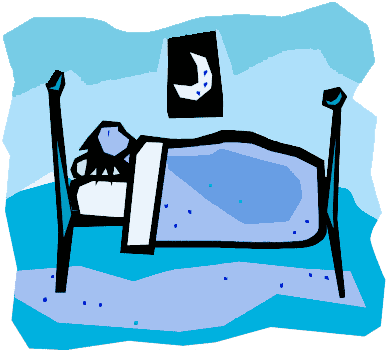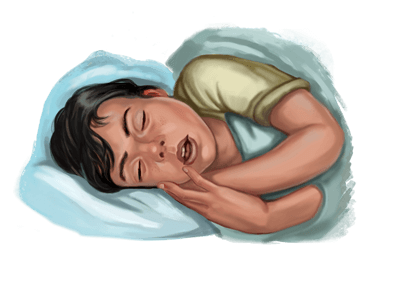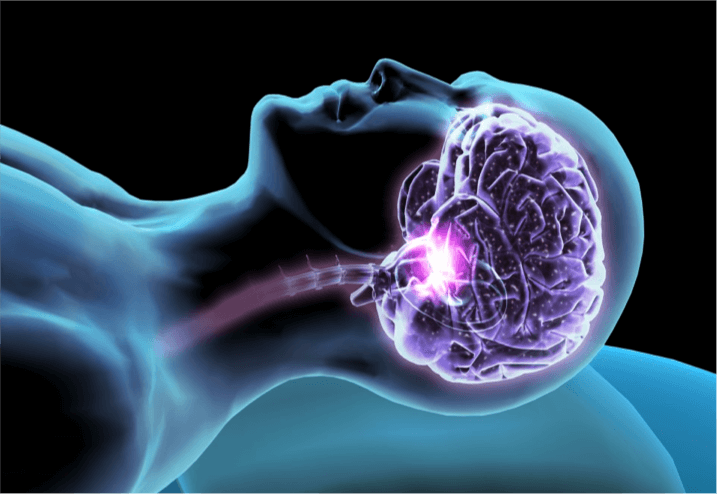Putting to bed, we hope that in the morning we wake up awake and rested. But, often, the awakening does not please us either with vigor or a charge of fresh strength. We stand up hard and reluctantly, fatigue accumulates with each passing day and results in prolonged stress, which we all the time are trying to compensate for something.
In fact, why is this happening? Why does a dream, aimed at restoring a person’s strength, seem to take them away? And in the morning we feel heavier than before we go to bed.
It's very simple, if you revert to our model of dreams. According to her principles, in the process of dreaming, we give and receive energy - awareness. At the same time in 6/7 of the total sleep time we give. And what, and how much, and always accept? Only the final 1/7 phase of sleep can fill us with energy costs in full. If you wake up a person at the moment of being in the sprite phase (the phase of slow sleep) - he will feel himself awake. Having woken up at the end of the cherished 1/7 phase of sleep in the role of location adept, there will be no desire to sleep on waking, on the contrary, one will feel vigor and fullness of strength.
You should always take into account the cyclical patterns of sleep, when you plan time, setting the wake-up time on the alarm clock. It is preferable to wake up early, but at the required time than later, but at the moment when your perception is energetically depleted.
Figure 19. Optimal awakening time (see appendix)
The best time to wake up is the end of each cycle in 90 minutes. Looking at pic. 17, it can be noted that with each cycle the duration of the REM phase increases. This happens if the dreamer falls into megalocations of a higher order. The duration of stay in the phase of the adept increases with increasing order. Biologically, this is due to the passage through itself of larger streams of awareness. The subjective perception of time changes in this case, but in reality we have an increase in the real time of being in a dream. However, we will talk about Time later separately.
|
In order to wake up in the correct phase of sleep, you need to know the approximate amount of time it will take to fall asleep and the preferred time to wake up. The time for which you need to set the alarm is calculated by the formula: Alarm = D + [(A - B) / 90] * 90 A is the time from the moment when you set the alarm to the time you need to get up, B is the time required for falling asleep, D is the point in time when you set the alarm is incomplete quotient, that is, rounding the result of the division to a whole side, Alarm - the time for which the alarm should be set. For convenience, time is taken in minutes. Simply put, you should set aside for sleep only a whole number of cycles of 90 minutes, without taking into account the time required for falling asleep. If the end of the cycle falls into an earlier wake-up time than is required - then in this case it is better to get up earlier and feel awake and sleep. Otherwise, you will sleep more, but the state of health upon awakening will be unpleasant. |
Put in order the time of awakening - and you will feel a significant increase in daily performance and efficiency when acting in a dream.
While we sleep, various processes occur in our body, our brain is active, and sleep can be divided into stages: REM sleep and slow. During sleep, such stages are repeated sequentially, on average, 4-5 cycles of fast and slow sleep pass overnight.
The brain works differently at each stage, on some limbs can move, on others the body remains stationary.
REM sleep phase. During this phase, brain activity increases, muscles are in a relaxed state, a sign of this phase is the rapid movement of the eyeballs. The first episode of REM sleep comes about 70-90 minutes after falling asleep, lasts 5-10 minutes. The duration of each next phase increases.
This phase lasts an average of 90-120 minutes per sleep cycle.
It is believed that the dreams that we remember, fall just in the phase of slow sleep, the period of the last cycles. It is assumed that fast sleep provides psychological protection functions, processing information, its exchange between the conscious and subconscious.
Phase of slow sleep. The deepest sleep stage lasts 80-90 minutes. It comes immediately after falling asleep.
Within the slow sleep phase, there are 4 subphases or periods:
1. Start sleep or nap. In this phase, when you fall asleep, you may feel cramps in the limbs, a feeling of falling. During this phase, our brain continues to analyze the information received during the day, during this period there may be an awareness of how to solve problems or bursts of creativity.
2. Light sleep, taking almost half the time. During this phase small bursts occur. brain activityIt is easy to wake up the person, turning off the consciousness of “sleepy spindles” into pauses between spindles (and they occur about 2–5 times per minute).
3. The third stage of slow sleep is intermediate, it does not have any bright differences from others. It is hard to wake a person during this stage, but if he woke up, then he feels disoriented for a while.
4. Stage sound sleep, deep dream. In this stage, bouts of sleepwalking, talking, in children with enuresis occur most often. It is at this stage that it is hardest to wake up, you will feel tired and weak.
So how do you apply knowledge of the physiological patterns of our body in practice, how much do you need to go to bed in order to feel light and be rested in the morning? The calculation of the sleep phase will help you be more cheerful in the morning!
Sleep phases can be calculated on the basis of their duration and brain activity during these periods.
The slow sleep phase lasts an average of 2 hours, the quick sleep phase lasts 20 minutes. As mentioned above, the greatest activity of the brain is in the phase of fast sleep, this state of the brain is similar to the state of wakefulness.
That is, every 2 hours and 20 minutes you can wake up pretty easily. The average duration of sleep, in order for the body to regain its strength, is 6-8 hours, based on the patterns of sleep phases, you can easily count 4-5 intervals of 2 hours and 20 minutes and set the alarm at the right time.
However, there are certain nuances. This timing implies accuracy. There is no guarantee that you can immediately fall asleep, if you are very physically tired, the time spent in the phase of slow sleep increases.
Sleep is a natural process for our body. And more and more people ask me how much sleep do you need to get enough sleep? Therefore, in this article, we will understand today: what is a dream, the features of this state and how much sleep you need to wake up easily and with vigor.
We will not go into deep physiological knowledge, this is to nothing. We will master a sufficient level, which will allow to sort out the question and give grounds for drawing up individual recommendations, in answering the question: "How much should you sleep?".
Sleep and its features
First, let's look at what a dream is. Let's get to the definition simply. Sleep is a natural physiological state of the body that promotes relaxation. nervous system, which starts intensive processes of cleansing the body, restoring the body after a period of wakefulness.
Thus, it becomes clear the importance of night sleep. Now, we need some reason to make it clear how much to sleep, healthy person. Sleep, like any other human condition, has a certain cyclical nature. Sooner or later, after a period of activity, a state of passivity begins. So the sleep cycle consists of two phases: slow sleep and fast sleep. In some sources you will find that sleep has five phases, but this is too subtle a division, useful only to physiologists and doctors.
So, the sleep cycle consists of two phases. The first answer to the question of how much to sleep such is from three to five cycles. If there are less or more cycles, you will feel discomfort, lethargy, and so on.
How much to sleep
Got to a direct answer. Nobody knows how much exactly to sleep. I will explain. Duration of sleep for each individual. You can find in the literature averages of 7-8 hours. But at the same time one person sleeps 4 hours and the other 10. Average seven.
But, from the point of view of maintaining health, as stated above, it is necessary to sleep so that about 3-5 cycles of sleep pass. The average duration of one cycle is from 1.5 to 2 hours. It depends on various factors. For most people, this figure is an hour and a half.
Since we had previously agreed that it is necessary to decide how much to sleep individually for everyone, let us return to the question of how easy it is to wake up. To do this, you need to wake up in REM sleep. It takes about 15-20 minutes from the entire cycle. When you wake up in this phase, you feel light, rested, and alert.
To calculate the best time to go to sleep or wake up below, I suggest you a night time sleep calculator. Here you will find how much you need to sleep and pick a convenient time for yourself.
Enter the estimated sleep time or estimated wake-up time into the calculator. Please note that the process of falling asleep at this time is not included. It takes about 15 minutes on average. That is, if you put time to bed at 23.00 you need to go to bed at 22.45. So you fall asleep at the right time.
Sleep calculator.
| Enter bedtime | ||
| Clock | Minutes | Calculation button |
Wake up time |
||
| Enter wake up time | ||
| Clock | Minutes | Calculation button |
| 1 2 3 4 5 6 7 8 9 10 11 12 13 14 15 16 17 18 19 20 21 22 23 24 | 00 05 10 15 20 25 30 35 40 45 50 55 | |
In a healthy person, as a rule, biphasic sleep. Experts distinguish two phases of sleep: fast and slow. They alternate within one cycle and, in turn, are also divided into several stages. How long can one full cycle last? Its duration is usually 1-2 hours. Much of this time is represented by the slow phase.
Note that the body is able to fully recover only when the correct ratio of sleep periods is observed. After all, each of them is characterized by special functions. Many people at least once felt unwell after waking up. This happens if a person wakes up in a slow phase. During the night, sleep cycles replace each other 4-5 times. How does the phase calculation of sleep?
Slow phase
A slow period is necessary for the body to restore its physical functions - renewing cells and internal structures, replenishing energy reserves, growing muscles, releasing hormones.
This phase is divided into 3 stages of sleep:
- Drowsiness (falling asleep). This stage is quite short - it lasts about 10 minutes.
- Light sleep The consciousness is disconnected and at the same time acoustic sensitivity increases. Therefore, you can wake a person very easily.
- Slow sleep. Stage strong, deep sleep. Eyeballs practically do not move. At this time interval accounts for more than half of all dreams. Their plot is usually neutral, and they rarely bump into memory. It is sometimes very difficult to “pull” a person out of the slow stage. By the way, somnambulism appears during this period. But only for those who have a tendency towards him.
The last stage of the slow phase is extremely important. At this time, the body is restored at the cellular level. You can disrupt this process by frequent waking up during the night. As a result, in the morning fatigue and lack of energy necessary for active life are felt.
You can increase this phase with physical exertion (sports) for 3-6 hours before going to bed or a hot relaxing bath.
Fast phase
When the dream switches to the fast phase mode, the “general cleaning” in the emotional and intellectual spheres begins. In full swing:

Within one cycle, the phase of REM sleep begins after a slow one and is about a quarter of it. Fast sleep is needed in order for the brain to be able to process and systematize information received throughout the day. In addition, it is necessary to restore the nervous system as intensively as possible.
As for the physiological state of people in fast phaseNote that it is very different from what is happening in the slow:
- the sleeping person breathes unevenly;
- heartbeat rhythm stray;
- muscle tone is reduced;
- eyeballs are moving rapidly.
REM sleep is the active phase. Therefore, it is characterized by the most vivid and well-remembered dreams. It is extremely easy for a person to leave it. And after the morning awakening, he feels just fine - there is a freshness and energy boost.
Together with the change of sleep periods, their effects on the body also change. With the approach of morning, the share of the fast phase increases, while the share of the slow phase, on the contrary, decreases. If the total duration of rest is limited by force, then it is the fast phases that will shrink in time, and the slow will remain almost unchanged.
Duration of sleep periods
Scientific studies prove that a two-phase sleep of an adult person implies a duration of the slow phase at about 75-85%, and a fast one - about 15-25% of the total time spent on night rest. A full sleep cycle lasts about 1.5 hours. While we sleep, he has time to repeat from 4 to 6 times.
 Have baby these stages are distributed differently: about 50% of the cycle falls on fast sleep (the so-called paradoxical phase). This indicator is gradually shrinking, and during the adolescence phase baby sleepfinally stabilize at an adult level.
Have baby these stages are distributed differently: about 50% of the cycle falls on fast sleep (the so-called paradoxical phase). This indicator is gradually shrinking, and during the adolescence phase baby sleepfinally stabilize at an adult level.
In a healthy person, night rest periods should always be repeated in the same sequence. But age and various disorders can make dramatic changes in such stability. For example, in the venerable years, the fast phase is only 17-18%, and the slow phase can disappear altogether, causing the appearance of age-related insomnia.
Some people, unfortunately, cannot sleep fully - as a result of a trauma of the brain or spinal cord, they have lost a normal two-phase sleep. It is more like a half-dream or a little short oblivion without any dreams. There are those who do not sleep at all, doing without even a short rest.
Some people suffer from numerous long awakenings in the middle of the night. “I don't sleep at night at all,” they usually say. And they are not only awakened in the quick phase.
The duration and correctness of the sequence of stages can also be affected by the emotional sphere, temperament. In impressionable people and people in life difficulties, the fast phase is lengthened. And for manic individuals, on the contrary, it shrinks to 15 or 20 minutes per night.
We emphasize that on what time a person went to sleep depends on the value of night rest. For example, in just 1 hour you can relax perfectly, as if all night, or not to sleep at all.
There is a table that shows the phases of a person’s sleep over time values of a night's rest.
How to calculate the optimal time to wake up
 A person needs all levels of sleep so that his body can fully recover. The best option is when his nightly rest consists of at least 4 complete cycles containing fast and slow phases. Just perfect if these cycles end before 4:00, because at a later time there is almost no slow sleep. But this does not mean that you have to get up every day so early. Sleep intensifies the recovery of the nervous system just after 4 am, when the duration of the fast phase increases.
A person needs all levels of sleep so that his body can fully recover. The best option is when his nightly rest consists of at least 4 complete cycles containing fast and slow phases. Just perfect if these cycles end before 4:00, because at a later time there is almost no slow sleep. But this does not mean that you have to get up every day so early. Sleep intensifies the recovery of the nervous system just after 4 am, when the duration of the fast phase increases.
To rest was really beneficial for the body, you need to go to bed early. Then there will be enough slow phases to replenish its reserves.
Many are wondering if there is any method by which one can calculate when it is best to get up in order to feel vigorous and energetic in the morning. The ease of awakening primarily depends on the phase in which the person is at the moment.
If a person wakes up in a slow phase, he will feel tired. Therefore, it is better to interrupt the sleep phase fast. Hourly sleep tracking will make it possible to calculate the optimal time for awakening. You can do this with the help of a graph or a special calculator.
If we consider that the duration of one cycle is 2 hours, of which 20 minutes is a fast sleep, you can calculate for yourself how much is best to wake up in the morning. It is necessary to proceed from the fact that for a full recuperation of the body it takes from 6 to 8 hours. Thus, you should count a few 2-hour cycles and set the alarm.
Check how comfortable it will be for you to wake up in the fast phase, you can only experimentally. However, no one guarantees that falling asleep happens instantly. Therefore, in the calculations it is desirable to take into account some errors.
And finally
 For the normal functioning of the whole body, each phase of sleep is important. Neglecting at least one period has unpredictable consequences. Also, most people know exactly how many hours they need to sleep in order to get up the next morning in a vigorous and full of energy.
For the normal functioning of the whole body, each phase of sleep is important. Neglecting at least one period has unpredictable consequences. Also, most people know exactly how many hours they need to sleep in order to get up the next morning in a vigorous and full of energy.
Knowing the total time spent on night rest, you can calculate the required number of cycles. It will take about a month to clearly determine the rhythm of your own sleep and develop the correct mode for yourself. But the wonderful well-being and mood are worth it.
If you consider yourself inconvenient or not, it is recommended to purchase a fitness bracelet (Jawbone Up). He has the ability to fix the time during which the rest lasted, tracking its phases and measuring their duration.
Every day, or rather every night, we are confronted with a dream. Scientists have conducted hundreds and thousands of studies, but still it remains a mystery even to them.
They are 100% sure only of the following facts:
- a person needs 6-8 hours of sleep per day;
- sleep is heterogeneous and is divided into phases and cycles;
- mental connection with the outside world during sleep is absent.
Of particular interest are the phases of sleep. A sleeping person cannot determine at what stage of sleep he is now, but this is easily fixed by special devices. In particular, they record the activity of the brain.  Based on these data, scientists identify two main phases of sleep: the first is slow and the second is fast. But how do these phases of sleep calculate the average person, and what is it for?
Based on these data, scientists identify two main phases of sleep: the first is slow and the second is fast. But how do these phases of sleep calculate the average person, and what is it for?
Sleep phases
To understand how to calculate the phases of sleep, it is necessary to understand their structure.
The phase of slow sleep comes immediately after falling asleep. At this time, the body enters the first stage of slow sleep, drowsiness.
In total, four stages of slow sleep are distinguished:
- Nap. At this stage, the brain continues its activity by inertia, gradually reducing it. A person falls into a dream, but this is not a deep sleep and periodic waking up is possible.
- In the second stage, the body calms down, and the consciousness is turned off. There is an increased sensitivity to sounds, muscular activity decreases.
- The third phase is very similar to the second and the difference between them is only in the intensity of the brain (often the second and third phases are combined into one).
- The deepest of all phases of sleep. It is at this stage that we have calm dreams.
Interestingly, the phenomena of sleepwalking and talking in a dream fall on this phase.
Fast sleep . The name fully justifies the peculiarity and duration of this phase. The fast sleep phase lasts much less than the slow one. At this time, increased brain activity is recorded. Our eyes intensively "run". The body is preparing for awakening.
Slow sleep + Fast sleep = cycle. During the night there can be from 4 to 6 such cycles.
Why is it necessary to calculate the phases of sleep?
Phases differ not only in duration, but also in purpose.
In the phase of fast sleep, the brain processes all the information that came in a day. Synchronizes and organizes knowledge and skills. This explains the fact that in babies this phase takes up about 50% of the total sleep.
 Slow sleep is responsible for the restoration of physical strength of the body. At this time, the brain gets a good rest.
Slow sleep is responsible for the restoration of physical strength of the body. At this time, the brain gets a good rest.
By calculating the phases according to the clock, we will ensure not only easy waking up in the morning, but also:
- normal functioning of the cardiovascular system;
- good complexion, clarity of look and good appearance;
- proper metabolism, healthy appetite;
- stable emotional state;
- extension of youth and health.
Knowing the phases of a person’s sleep and their characteristics, everyone can calculate the individual bedtime or wake-up time.
Temporary sleep phases
 Slow sleep takes 75% of the total number of hours of sleep. Accordingly, the fast sleep remains 25%.
Slow sleep takes 75% of the total number of hours of sleep. Accordingly, the fast sleep remains 25%.
After falling asleep, in the first cycle the duration of slow sleep is 80-90 minutes. From cycle to cycle, its numerical index decreases.
The fast phase in the first cycle is only about 5 minutes. In contrast to the slow, this phase increases from cycle to cycle.
Important: a person needs 7 hours of sleep per day, but this period can be divided into several, i.e. sleep a few hours night and day.
Calculate the phase yourself
In order to calculate the phases of sleep with the necessary accuracy, it is necessary to spend a certain amount of time. This information is valuable, especially for you. You may have to adjust the mode of the day, but the result is worth it.
Important: if you wake a person in the phase of slow sleep, he will feel sleepy and irritated. Therefore, it is important to remember which phase is better to wake up and put it into practice.
In average, the duration of the entire sleep is about 7 hours. That is, if you go to bed at 23.00, then you need to start the alarm at 6.00.
After watching your feelings for several days, you can adjust this time on your own.
Most often, we have to build on the time of recovery (as we need to have time to work, to school or university). In this case it is necessary to move the time of falling asleep.
Calculation methods
Independent calculation of the sleep phase is quite complicated. Online, you can find sleep calculators.
This innovation is suitable for those who do not want to spend time on calculations. Knowing only the time of departure to the world of morpheus, you get the exact time of awakening.
The disadvantage of this method is that it is based on averages and does not take into account individual characteristics.
 The most reliable and accurate way is to contact specialized laboratories and centers.
The most reliable and accurate way is to contact specialized laboratories and centers.
Having connected devices and having measured activity of a brain on various fluctuations and waves, at the exit you receive exact data on phases and cycles.
To take them for a constant value is not worth it. They are subject to change and depend on the well-being, emotional and physical saturation of the day.
Rate this article: